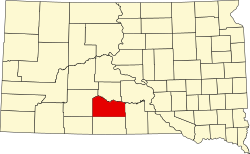Mellette County | |
|---|---|
 White River from the West, the county seat | |
 Location within the U.S. state of South Dakota | |
 South Dakota's location within the U.S. | |
| Coordinates: 43°34′52.802″N100°45′18.756″W / 43.58133389°N 100.75521000°W | |
| Country | |
| State | |
| Founded | 1909 (created) 1911 (organized) |
| Named after | Arthur C. Mellette |
| Seat | White River |
| Largest city | White River |
| Area | |
• Total | 1,311 sq mi (3,400 km2) |
| • Land | 1,307 sq mi (3,390 km2) |
| • Water | 3.6 sq mi (9.3 km2) 0.3% |
| Population (2020) | |
• Total | 1,918 |
• Estimate (2024) | 1,834 |
| • Density | 1.467/sq mi (0.5666/km2) |
| Time zone | UTC−6 (Central) |
| • Summer (DST) | UTC−5 (CDT) |
| Congressional district | At-large |
Mellette County is a county in the U.S. state of South Dakota. As of the 2020 census, the population was 1,918. [1] Its county seat is White River. [2] The county was created in 1909, and was organized in 1911. [3] It was named for Arthur C. Mellette, the last Governor of the Dakota Territory and the first Governor of the state of South Dakota.
Contents
- Geography
- Major highways
- Adjacent counties
- Demographics
- 2020 census
- 2010 census
- Communities
- City
- Town
- Census-designated places
- Unincorporated communities
- Townships
- Unorganized territories
- Politics
- See also
- References
- Further reading
Historically territory of the Sioux/Lakota peoples, 33.35 percent of the county's land is trust land associated with the Rosebud Indian Reservation in the neighboring county to the south. According to the 2000 United States census, 52.2% of the population is Native American, mostly the federally recognized Sicangu Oyate (Upper Brulé Sioux) and the Rosebud Sioux Tribe, a branch of the Lakota people.

